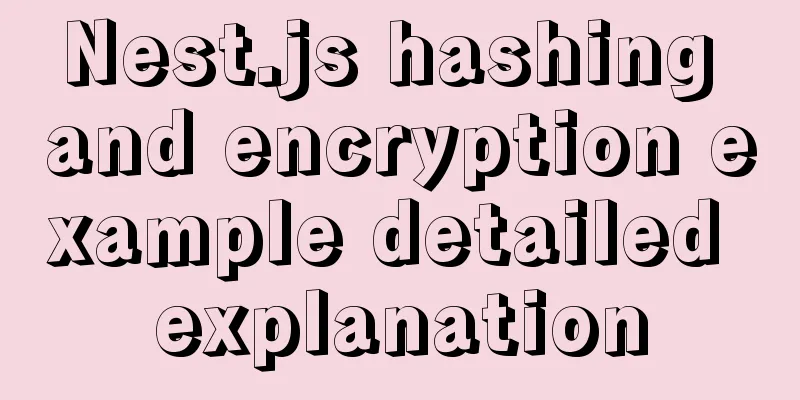Nest.js hashing and encryption example detailed explanation

0x0 IntroductionFirst of all, what is a hash algorithm? An algorithm that produces a hash value for some piece of data, such as a message or session item. For example, md5 is a hashing algorithm. A hash function or hash algorithm in software development, also known as a hash function, is a method of creating a small digital "fingerprint" from any kind of data. All hash functions have a fundamental property: if two hash values are different (according to the same function), then the original inputs to the two hash values are also different. Encryption algorithms are usually divided into symmetric encryption algorithms and asymmetric encryption algorithms. For symmetric encryption algorithms, both parties receiving the information need to know the key and encryption and decryption algorithm in advance and their keys must be the same. Then the data can be encrypted and decrypted. The asymmetric algorithm is different from this. The sending parties A and B generate a bunch of keys in advance, and then A sends its public key to B, and B sends its public key to A. If A wants to send a message to B, he first needs to use B's public key to encrypt the message, and then send it to B. At this time, B uses its own private key to decrypt the message. The same principle applies when B sends a message to A. Essentially, hashing and encryption both turn an object into a meaningless string. The difference is that the hashed object cannot be restored and is a one-way process. For example, passwords are usually encrypted using a hashing algorithm, so if a user forgets their password, they can only modify it and cannot obtain the original password. However, the encryption of information is a regular encryption algorithm, and the encrypted information can be decrypted and restored by the secret key. Hashing and Encryption Hashing is the process of converting a key value into another key value through a mathematical algorithm. The hash function is used to generate the conversion, and the output content cannot be restored. It is mainly used for password storage when data needs to be hashed. Encryption is the encoding of information, converting the original information into ciphertext. It is generally used for the client to send sensitive information such as passwords to the server. The information is encrypted before sending and then decrypted on the server. 0x1 HashingThe Node.js ecosystem has many dependencies, such as Bcrypt and Argon2, which are simple to use. This time, Bcrypt is used to implement the hashing process: yarn add bcrypt yarn add @types/bcrypt -D Then encapsulate the hashed business:
import { Injectable } from '@nestjs/common'
import * as bcrypt from 'bcrypt'
@Injectable()
export class BcryptService {
private static readonly SALT_ROUNDS: number = 10
/**
* Compare and check password * @param rawStr
* @param hashedStr
*/
async compare(rawStr: string, hashedStr: string) {
return bcrypt.compare(rawStr, hashedStr)
}
/**
* Generate hash
* @param rawStr
* @param salt
*/
async hash(rawStr: string, salt?: string) {
return bcrypt.hash(rawStr, salt || BcryptService.SALT_ROUNDS)
}
/**
* Generate salt */
async genSalt() {
return bcrypt.genSalt(BcryptService.SALT_ROUNDS)
}
}
0x2 EncryptionThe Node.js system comes with an encryption module that can be used for encryption and decryption and other related operations. The following uses AES-256-CTR encryption to encrypt data:
import { createCipheriv, randomBytes } from 'crypto'
import { promisify } from 'util'
const iv = randomBytes(16)
const password = 'Password used to generate key'
// The key length depends on the algorithm // In the case of aes256 it is 32 bytes long const key = (await promisify(scrypt)(password, 'salt', 32)) as Buffer
const cipher = createCipheriv('aes-256-ctr', key, iv)
const textToEncrypt = 'Nest'
const encryptedText = Buffer.concat([
cipher.update(textToEncrypt),
cipher.final()
])
If you need to decrypt it is also very simple:
import { createDecipheriv } from 'crypto'
const decipher = createDecipheriv('aes-256-ctr', key, iv)
const decryptedText = Buffer.concat([
decipher.update(encryptedText),
decipher.final()
])
0x3 ReferenceEncryption and Hashing Node.js crypto node.bcrypt.js SummarizeThis is the end of this article about Nest.js hashing and encryption. For more related Nest.js hashing and encryption content, please search 123WORDPRESS.COM's previous articles or continue to browse the following related articles. I hope everyone will support 123WORDPRESS.COM in the future! |
<<: Mysql database master-slave separation example code
>>: Nginx operation and maintenance domain name verification method example
Recommend
MySQL slave library Seconds_Behind_Master delay summary
Table of contents MySQL slave library Seconds_Beh...
How to use Baidu Map API in vue project
Table of contents 1. Register an account on Baidu...
Why do select @@session.tx_read_only appear in DB in large quantities?
Find the problem When retrieving the top SQL stat...
Vue3.0 uses the vue-grid-layout plug-in to implement drag layout
Table of contents 1. Plugins 2. Interlude 3. Impl...
Detailed explanation of the difference and application of CSS3 filter:drop-shadow filter and box-shadow
To use standard CSS3 to achieve the shadow effect...
Install Memcached and PHP Memcached extension under CentOS
Regarding the high-performance distributed memory...
MySQL statement to get all dates or months in a specified time period (without setting stored procedures or adding tables)
mysql gets all dates or months in a time period 1...
How to lock a virtual console session on Linux
When you are working on a shared system, you prob...
A brief discussion on the calculation method of key_len in mysql explain
The MySQL explain command can analyze the perform...
Solve the problem of using linuxdeployqt to package Qt programs in Ubuntu
I wrote some Qt interface programs, but found it ...
Hyperlink icon specifications: improve article readability
1. What is the hyperlink icon specification ?<...
Usage of MySQL time difference functions TIMESTAMPDIFF and DATEDIFF
Usage of time difference functions TIMESTAMPDIFF ...
How to use port 80 in Tomcat under Linux system
Application Scenario In many cases, we install so...
Detailed explanation of Docker+Jenkins+Gitlab+Django application deployment practice
1. Background In the context of rapid updates and...
Solution to span width not being determined in Firefox or IE
Copy code The code is as follows: <html xmlns=...









